This was going to be a post about one thing: shaping a fendu loaf. Then I ended up having to improvise a little with the dough formula, so it will be about that, too.
First, the fendu: I’ve been getting a little bored with basic batards lately, so I thought I’d do something just a bit different. A fendu (French for “split”) loaf is an easy variation that looks cool and offers a nice respite for those with scoring anxiety.
The fendu can be made with any shapeable dough, but my understanding is that it is traditionally done with country French bread (pain de campagne), which is a basic French bread, made with sourdough or other preferment and a portion of whole grain flour (rye and/or whole wheat).
 To shape the fendu, first shape a batard. Make it a bit stubby; it will elongate into a torpedo as you complete the shaping process. Place the batard on a lightly floured counter, and sprinkle a little flour on the top.
To shape the fendu, first shape a batard. Make it a bit stubby; it will elongate into a torpedo as you complete the shaping process. Place the batard on a lightly floured counter, and sprinkle a little flour on the top.
With a dowel (or, if you can’t find one, a new (undented) drumstick, like the one I borrowed here), press into the center of the loaf the loaf firmly along the long axis.
Roll the dowel back and forth to make a “hinge” about two inches wide and 1/8-inch thick. Sprinkle the hinge very lightly with flour.
Roll the two halves of the loaf back toward each other so they touch. Place the loaf, split side down, in a floured couche or linen-lined banneton to proof.
After proofing, the split may look rather indistinct, but it should open up during baking.
Bake the loaves split side up, and voilà!
Now, about the dough. My plan was to do a variation on Norwich Sourdough, substituting whole wheat flour for half of the pumpernickel. Then I realized I had to be somewhere before the bread would be done, so I planned to spike the dough with a little yeast (3/8 t.) for faster fermentation. Then I realized I had elaborated my starter into only about half of what I needed, so I doubled my original amount of yeast and increased the flour and water to make up for the missing starter.
So it’s not the dough I would usually make, but the bread was done in 4 1/2 hours from start to finish, the crust was a whole lot more crispy-crackly than what I usually get using a higher proportion of starter, and the taste still beats most store-bought bread by a mile.
Country Semi-Sourdough
Yield: 1 kg (two loaves)
Time:
- Mix/autolyse: 25 minutes
- First fermentation: 1.5 hours
- Divide, bench rest, and shape: 25 minutes
- Proof: 1 – 1.5 hours
- Bake: 30 minutes
Desired dough temperature: 78F
Ingredients:
- 496 g white flour (I used Giusto’s Golden Haven organic)
- 31 g whole rye flour (I used KAF organic pumpernickel)
- 31 g whole wheat flour (I used Whole Foods organic)
- 339 g water at about 70F
- 138 g ripe 100% hydration sourdough starter
- 12 g salt (2 t.)
- 2.25 g instant yeast (3/4 t.)
Method:
- In the bowl of a stand mixer, mix the flours, water, and starter on low speed until just combined, about one minute.
- Let the dough rest (autolyse) for 20 minutes.
- Add the salt and yeast and continue mixing on low or medium speed until the dough reaches a medium level of gluten development. This should only take about 3 or 4 minutes.
- Transfer the dough to an oiled container (preferably a low, wide one so the dough can be folded without removing it from the container).
- Ferment at room temperature (72F – 76F) for 1.5 hours, with folds at 30 and 60 minutes.
- Turn the dough out onto a lightly floured counter. Divide it into two pieces and preshape them into light balls.
- Sprinkle the balls lightly with flour, cover loosely with plastic, and let rest for 15 minutes.
- Shape into fendu batards and place split side down in a floured couche or linen-lined bannetons.
- Slip the couche or bannetons into a large plastic bag or cover with plastic wrap and proof at room temperature for 1 – 1.5 hours.
- Meanwhile, preheat the oven, with baking stone, to 475F. You will also need steam during the initial phase of baking, so prepare for this now.
- Turn the proofed loaves, split side up, onto a semolina-sprinkled peel or parchment.
- Once the loaves are in the oven, turn the heat down to 450F. Bake for 10 minutes with steam, and another 20 minutes without steam. The crust should be a deep brown. For a very crisp crust, turn off the oven and leave the loaves in for another 5 minutes with the door ajar.
- Cool on a wire rack. Wait until completely cool to cut and eat.
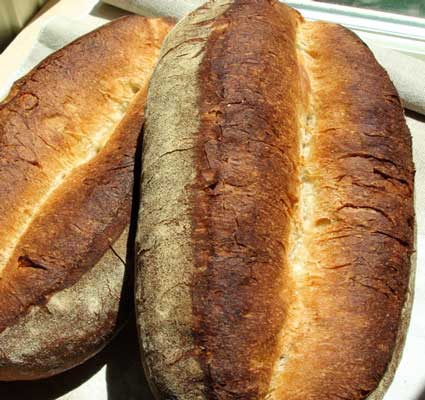

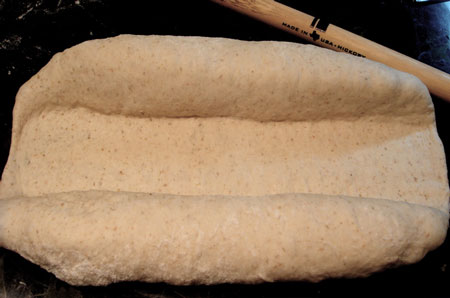
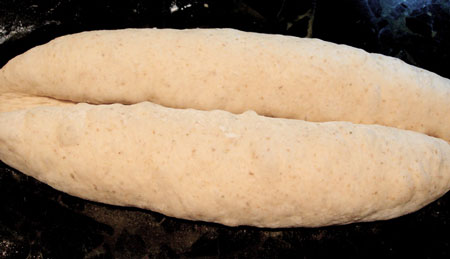
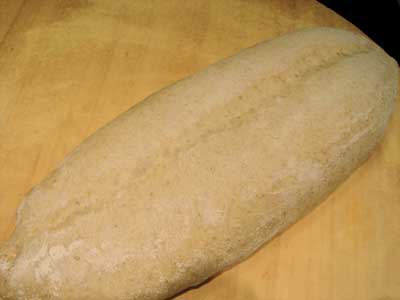
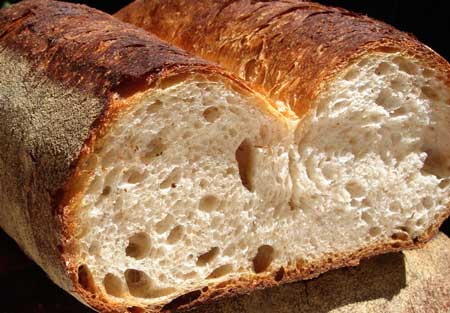
Susan, you do beautiful work all right. You make the fendu sound and look so easy.. what about all the trauma and angst re trying to keep the hinge open? Apparently not an issue in your world. I had been feeling a little reluctant to try it but this certainly is what I call encouragement. I’m interested to hear what you say about crust difference in the spiked vs straight sourdough. Is this typical for you?
Browndog: uh-oh, it certainly wasn’t my intention to provoke trauma and angst! I guess with a really elastic dough it could be challenging, but you could roll it a little wider than you need to allow it to spring back some, and you really only need it to stay open long enough to roll the halves together. With this dough, the autolyse helps it be more stretchy, I think. Also, I’m not the world’s best at shaping a very tight batard, and maybe that works in my favor here. Please try the fendu and tell me how it goes.
I have noticed that in general a lower proportion of preferment (sourdough or other) gives me a crisper crust. I don’t know the theory behind that, but I’m sure there is one. Can someone enlighten us?
Hi Susan! OH MY GAWD! Just when I thought it was safe to go back in the kitchen! 😉 The fendu is knockout gorgeous! I am always so jealous of your crumb, too! Your instructions and recipe is so easy to follow and the piccys are great!
t/j – Hi browndog!
(I finished baking the Vermont SD last night. Will try to get the write up and piccys done today!)
I’m overwhelmed. This is fantastic bread!
Wonderful pictures to follow this shaping!
Susan, you’re not provoking the angst, you are rather assuaging it. I’m just recollecting a fendu thread at tfl where it seemed like a major challenge to keep the sides from gluing back shut, people were scratching their heads very hard and as I recall dumping lots of flour on the hinge.
Ha! How silly of me not to have noticed your name at the top of the article in “Just Baking”! I would have commented here rather than there, if I had been paying attention…
Great photos. I can’t tell you how useful your site has been – especially right now as I am just starting my adventure with wild yeast.
-Elizabeth
Beautiful! Fendu is one shape i’ve not tried yet, but with a tutorial this thorough, i’ll have to give it a shot! I have to say, I’m big fan of your idea to leave the door cracked for the last few minutes of baking. Last night i made some serrano/cheddar levain baguettes, tried it, and got a much improved crust. I usually end up with a thick, really chewy and kinda crunchy crust, but their crust was crisp and crunchy as crunchy could be.
-ben
BZ & MyKitchenInHalfCups, I’m glad you like the photos. The shape really is quite easy and I was hoping the pictures would show that.
Browndog, I kind of remember that thread. I’m wondering if maybe the problem was the dough being too wet, which might cause the shape to lose definition during proofing.
Elizabeth, that was my first post to Just Baking. I’m happy you have found my blog helpful — that’s what I was aiming for!
Ben, serrano/cheddar baguettes sound intriguing!
Beautiful work, as always, Susan. I must try this one!
Susan: I found your fantastic blog through The Freshloaf. What beautiful breads you make! And thanks for including all of us on your bread baking adventures.
How do you like Giusto’s Golden Haven organic flour? I’ve been ordering Giusto’s Organic Baker’s Choice through my local health food store, but I understand that Golden Haven has malt added. Do you like it?
Thanks so much! Liz
Zainab, thank you.
Hi Liz, I’m glad you like the blog! This was my first time using the Golden Haven, but so far so good. Yes, it is malted. Malted organic flours are hard to find. I ordered this through a local natural foods store.
Susan, I don’t know how you find time to do all you do – you must be many years younger than me. I love your blog and just had to try the fendu recipe, and your pictures made it so clear. I bought a dowel from my local hardware store and had it cut in two. They were puzzled when I told them it was for baking bread. I mentioned on TFL that I have been having some sourdough problems but one had recovered enough to bake the fendu today. Maybe my dough was too wet, but one stuck together while the other one was perfect. Let me amend that – it looks great. Too hot to cut to check the crumb yet. I don’t have a mixer and I have great anxiety when it comes to kneading in salt, and this recipe yeast also. Is there some reason why the yeast can’t be added before the autolyse? I was thrilled to hear the crust “singing” when the loaves came out of the oven, and I hope it will remain crisp. I do hope Stripes is feeling better, that was such a lovely story. I adopted an ancient cat from the local shelter in March, having said no replacements when my Minnie died. Henry is a love and hopefully we will have a few years together. Thanks for everything, A
Annie, I’m so happy to hear about your fendu! Yeast and salt are not added to an autolyse (nor is a preferment, unless it is a liquid one and needed for its water content, as here) because they would work against developing the extensibility that is the purpose of this step.
Susan, I think your Semi-sourdough is my favorite bread! I managed to kill of my starter and had to begin again, and today I made the recipe using the new starter which is rampant and only 6 days old. I checked your pictures and made the “hinge” wider and more pronounced this time, and my loaves looked like yours. Plus the crumb has lovely holes – and it tastes good too. I have to admit now that I mixed all of the ingredients together for the autolyse. Then I performed fraisage (sp?) and stretched and folded twice. Even made a run into town in between. Guess the bread fairies were with me today. Thank you for the recipe, A
Thank you for keeping me posted about your experience with the fendu, Annie. I’m so glad you’ve been making it and having good results. I love success stories!
nice
Susan,
You always use such a lovely range of flours. Where do you procure most of yours? Do you mail order or buy them locally?
MommaT
Susan,
Thanks for this formula. Made it this week, and it came out wonderful! While my shaping is still a work in progress, the crust, crumb and flavor are terrific. Next time I may do an overnight poolish. But love that one can get a loaf of this quality in one day.